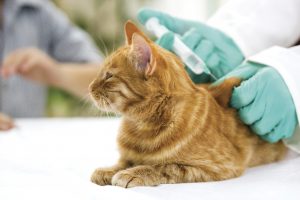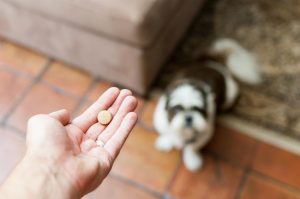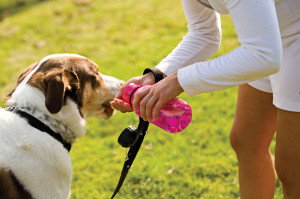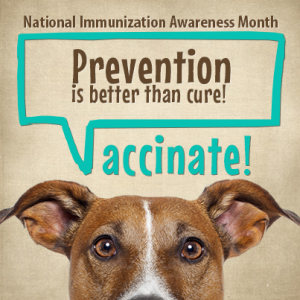Posts Tagged ‘pet immunization’
Everything You Ever Wanted To Know About Pet Vaccines
 Pet vaccines are important, and they have a long history. Probably the most important technological gains were discovered in the 1790’s by Dr. Edward Jenner. He discovered the first vaccination by giving people a preparation of material from cowpox, which was a common animal disease in cattle. The people that were injected with or “vaccinated” with the material did not get sick and remained healthy when they were exposed to the deadly smallpox virus. Over 100 years later, a French scientist by the name of Louis Pastuer, found that they could protect people and animals from disease by injecting altered forms of microorganisms.
Pet vaccines are important, and they have a long history. Probably the most important technological gains were discovered in the 1790’s by Dr. Edward Jenner. He discovered the first vaccination by giving people a preparation of material from cowpox, which was a common animal disease in cattle. The people that were injected with or “vaccinated” with the material did not get sick and remained healthy when they were exposed to the deadly smallpox virus. Over 100 years later, a French scientist by the name of Louis Pastuer, found that they could protect people and animals from disease by injecting altered forms of microorganisms.
The process of how a vaccine works is a complex reaction that involves many chemical and cellular reactions within and between the immune system cells of the body. Basically the role of the vaccine is to expose the immune system of the pet to viral and bacterial antigens that are contained in the vaccine. In the future, when the pet is exposed to that related organism, the body will recognize it and then activate the immune system to prevent the disease from producing or reducing the signs of clinical disease.
Vaccines can be administered by subcutaneous or intramuscular injections, intranasal or orally. The vaccines that are injected or given orally tend to produce a more systemic or whole body response, whereas the intranasal provides a more local response. Intranasal vaccines can be advantageous to provide a quicker response and prevent or kill the new virus before it can get any further in the body. Local nasal vaccines would not be helpful for a virus that has been ingested and causes intestinal disease such as parvovirus in dogs. For that we would want a vaccine that would produce a more systemic response.
The vaccines that we use in veterinary medicine are most generally either a killed or a modified live (attenuated) vaccine. There are multiple indications for both, but generally speaking the killed vaccines are safer and unlikely to cause disease in the immunocompromised pet. Whereas, the live vaccines provide a more amplified response that leads to a better, longer lasting immune protection. Several of the vaccines that we use have many different viruses in one injection. This allows to vaccinate for several of the organisms in one injection.
To confuse you even more, pets get some protection through the placenta when the puppies and kittens are in the mother’s uterus and when they get colostrum which is the first milk that they drink. This protection will decrease over time and usually will be low enough by 12 weeks of age where vaccinations will start reacting. There is no way to measure quick, easy and inexpensive way to measure the immunity gained here, so we generally recommend starting vaccines at 6 to 8 weeks of age and then booster them every 2 to 4 weeks until they are 16 weeks of age. Generally, it is not the number of vaccinations that they get, but when they get them at their chronological age.
A vaccine helps prime an animal against a specific disease. It does this by stimulating the immune system with a nonpathogenic virus or bacteria. If the animal responds adequately, it will develop cells that will help it to quickly and efficiently fight off the pathogenic form of the agent if it is encountered later. Here at Olsen Veterinary Clinic, we have tailored our vaccination programs to meet the needs of your pet. If you have any questions please feel free to contact us here, or call our office at 618-656-5868.
Human Medications and Pet Medications Are NOT Created Equal
 In today’s society, almost everyone has some medications – whether over-the-counter or prescription sitting around at home. The important thing to remember, however, is that human medications and pet medications are NOT created equal. While some human medications are safe, some can be very toxic to pets if they happen to ingest them. As a matter of fact, the Pet Poison Hotline reports that nearly 50% of the calls involve human medications. These issues can arise if your pet accidentally chewed into the pill bottle or a well-intentioned pet owner gave their pet a human medication. Pet poisonings are common, can be very serious, and spell disaster for a beloved pet.
In today’s society, almost everyone has some medications – whether over-the-counter or prescription sitting around at home. The important thing to remember, however, is that human medications and pet medications are NOT created equal. While some human medications are safe, some can be very toxic to pets if they happen to ingest them. As a matter of fact, the Pet Poison Hotline reports that nearly 50% of the calls involve human medications. These issues can arise if your pet accidentally chewed into the pill bottle or a well-intentioned pet owner gave their pet a human medication. Pet poisonings are common, can be very serious, and spell disaster for a beloved pet.
With that in mind, listed below are 10 medications that can cause toxicity to your pet and therefore should be kept away from them.
NSAIDS – Non-Steroidal Anti-Inflammatory Drugs are common, everyday drugs that are found in most households. This classification includes popular drugs like Aleve, Advil and Motrin. The side effects can be some of the most dangerous drugs for pets to ingest. In fact just 1 or 2 pills can cause pets to suffer serious stomach and intestinal ulcers and in some cases cause kidney failure.
Acetaminophin – For that occasional headache or fever, almost everyone has some Tylenol sitting around their home. As safe as it is for children the opposite is true for pets. Just a small dose of acetaminophin can cause damage to your pet’s red blood cells, reducing its ability to carry oxygen through the body. The drug can also cause liver damage in your pet.
Birth Control Pills – Dogs usually mistaken the birth control containers for toys, but if they swallow a large number, they can get ill. Estrogen and Estradiol have shown to cause bone marrow suppression in pets. Surprisingly, female pets have an increased risk of suffering from the most serious side effects.
Antidepressants – Veterinarians have at times prescribed medications meant for humans to pets like Prozac. When used as your veterinarian has prescribed, they are safe. But accidental or overdose can be toxic to your pet. These clinical signs can include serious neurological problems that include sedation, loss of coordination, tremors and even seizures.
ADHD/ADD Medications – Prescription medications for this human condition are very strong stimulants like amphetamines and are very dangerous for pets. Ingestion of small amounts can cause life-threatening tremors, seizures, elevated body temperature and heart problems. Drugs in this category include Adderall, Ritalin and Concerta.
Benzodiazepines and Sleep Aids – Drugs like Xanax and Ambien are given to humans to reduce anxiety and help sleep better. However in pets, it can cause the opposite. It has been shown that small doses can cause pets to be agitated, along with severe lethargy, incoordination, and a slowed breathing rate. In cats, it has been known to cause liver failure.
Beta-blockers – Beta-blockers are commonly prescribed drugs for humans suffering from blood pressure problems. But all it takes is a small amount for pets to ingest to make it life-threatening to them. These drugs can cause severe drops in blood pressure and a very slow heart rate.
Ace-Inhibitors – Like in humans, these drugs are often used in veterinary medicine to treat pets suffering from high blood pressure. Though typically safe, overdoses can cause low blood pressure, dizziness, and weakness. If pets have ingested just a small amount of this medication, they can be monitored at home unless they have kidney failure or heart disease.
Cholesterol-Lowering Drugs – Drugs like Lipitor are advertised on the TV and are now found in many households in America. While these drugs are considered statins, long term use can potentially leads to problems. In most cases, one may see some mild form of intestinal upset which would include vomiting or diarrhea.
Thyroid Hormones – These medications are routinely prescribed for pets that have underactive thyroids. Surprisingly the thyroid hormone needed to treat dogs is much higher than a persons dose. So, if dogs accidentally get into thyroid hormones, it rarely results in problems. In cats it can be a different story. Large overdoses in cats can cause muscle tremors, nervousness, panting, a rapid heart rate and aggression.
Most pets are naturally curious creatures so it is important to keep them out of reach from your pets. Here are some tips to help ensure that they never ingest your medicine.
- Never leave loose pills in a plastic sandwich bag-the bags are too easy to chew into. Make sure the rest of the family does the same, keeping their medications out of reach.
- If your medication is in a pill box or weekly pill container, make sure that it is safely stored in a cabinet. Too many pets may think that it is a plastic toy.
- Never store your pets medication near your medications. Pet poisonous hotlines received several calls every year from concerned owners who have inadventantly given their own medication to their pet.
- Hang up your purse or backpack. Curious pets will explore the contents of your bag and simply placing it out of reach solves the problem.
A lot of pet poisonings stem from pets ingesting human drugs and pets metabolize the drugs differently than humans do. So because of this, even safe over-the-counter medications may cause serious poisonings in pets.
If your pet has ingested a human over-the-counter or prescription or medication, please call your veterinarian, your local emergency animal hospital or the Pet Poison Hot Line’s 24 hour animal control center at 800-213-6680 immediately. Of course, if our office can be of any assistance, do not hesitate to call or contact us here.
How To Prevent Heatstroke With Your Pet
 With the dog days of summer upon us, we as pet owners need to be aware of heatstroke with your pet. This can be a life-threatening condition that occurs because your pet cannot lower its body temperature efficiently, so its body temperature increases to dangerous levels.
With the dog days of summer upon us, we as pet owners need to be aware of heatstroke with your pet. This can be a life-threatening condition that occurs because your pet cannot lower its body temperature efficiently, so its body temperature increases to dangerous levels.
There are many common situations that can set the stage for heatstroke. These include: strenuous exercise in hot, humid weather, being a brachycephalic (short-nosed) breed, suffering from heart or lung disease that interferes with efficient breathing, being confined without shade or shelter and fresh water in hot weather, being confined on concrete or asphalt and the most logical-left in a closed up car in the warm weather.
Heatstroke begins with heavy panting and difficulty breathing. The tongue and mucous membranes appear bright red. The saliva is thick and tenacious and the dog usually vomits. The rectal temperature rises to 104 to 110 degrees Fahrenheit. The dog becomes progressively unsteady and passes bloody diarrhea. As shock sits in, the lips and mucous membranes turn gray. Collapse, seizures, coma and death rapidly ensue.
It is important to take emergency measures to begin cooling your pet immediately. One suggestion would be to move it to an air-conditioned building and begin cooling your pet with spraying your pet with a garden hose or immersing it in cool water for up to two minutes. Also if possible, it is helpful to place the wet pet in front of an electric fan. Ice packs work well when applied to the groin and armpit areas because this is the area where the blood is the closest to the surface in the body. Monitor the rectal temperature and continue the cooling process until it falls to 103 degrees. Seeking veterinary assistance is of utmost importance since this is an emergency. Your veterinarian will take steps to reverse the effects of heat, dehydration, and low blood pressure. An IV catheter will be placed and fluids will be given to help get blood flowing to major organs again.
Treatment is aimed to supporting these organs in the hope that the damage that they have sustained isn’t permanent. Unfortunately, it will often take days to know which organs have been affected. Specific treatments may include antibiotics, blood pressure medications and blood transfusions.
Because heatstroke can be so deadly and strike rapidly, it is best to take steps to prevent it. In hot weather, it is best to exercise your pet during the coolest part of the day (early morning and late evening) and always provide plenty of fresh, cool water and rest. A person can also help their pet by cooling them by allowing them to swim or spray them off with a hose after exercising.
Never leave a pet in a car during warm weather-not even for a few minutes with the windows cracked. Brachycephalic dog owners should be extra vigilant, keeping their dogs inside in air-conditioning on hot days. All geriatric, obese, and respiratory compromised pets should be exercised with caution in hot weather.
So remember if your pet is acting distressed, start cooling it down and seek assistance from your veterinarian immediately.
Summer Dangers For Pets
 Oh the dog days of summer. What’s not to like about summer? Vacations, cookouts, swimming—can it get any better than that? Wait a dog gone minute though. These fun times can be hazardous to your pets, so care must be taken to make sure that they don’t succumb to the dangers that can be lurking. Accidents can happen almost anytime and anyplace so it is important to be aware of how to prevent them from happening. These can include but not be limited to heat stroke, swimming pools, venomous pests, campouts, bbq and other foods just to name a few. So let’s cover a few dangers to avoid and try to prevent.
Oh the dog days of summer. What’s not to like about summer? Vacations, cookouts, swimming—can it get any better than that? Wait a dog gone minute though. These fun times can be hazardous to your pets, so care must be taken to make sure that they don’t succumb to the dangers that can be lurking. Accidents can happen almost anytime and anyplace so it is important to be aware of how to prevent them from happening. These can include but not be limited to heat stroke, swimming pools, venomous pests, campouts, bbq and other foods just to name a few. So let’s cover a few dangers to avoid and try to prevent.
Summer Heat
The summer heat can be dangerous to our pets. Dogs are covered with hair, have very few sweat glands, and some breeds have shortened noses that make it tough to keep cool in the summer. So the easiest way to beat the heat is to adjust your walking schedule to the morning hours when it is cooler out. Some dogs may do well with having their haircoat shaved, however breeds like the Husky have a haircoat that also helps keep them cool in the summer.
The heat will also warm up the inside of your car, so if it is above 65 degrees either leave your pet at home or take it inside with you when you leave the vehicle.
Sunburn can also cause some problems, so it may be important to put sunscreen on the pets ears and bare skin to prevent this.
Swimming Pools
What is a better way to beat the heat than swim in a swimming pool? It is great and it also is a good way for your dog to get exercise. Floatation devices are available to assist the pets that are not strong swimmers. But, do not leave them unsupervised. It is important that they be taught how to exit the pool safely before they tire. Also having fresh water for them to cool off with and to remove the chlorine, salt and bacteria that can be harmful to them is beneficial. So keep a bowl handy by the pool.
Fireworks
Almost everyone celebrates the Fourth of July with fireworks. Dogs tend to not like loud noises and can be scared easily. The best advice would be to leave your pets at home inside and away from the flash of the fireworks.
BBQs
Some summer evenings are spent socializing with friends and barbecuing. We all like them, and even our pets are hoping for a few table scraps. A little of this and a little of that can be bad for pets—and not just their waistlines. Some surprising foods like grapes, onions, garlic and raisins, can be toxic to dogs if consumed in large quantities and should stay off their menu. Other barbecue staples like corn on the cob, bones, fruit with pits, skewers or ice cream can be dangerous to our four-legged family members. It may be helpful to talk to guests and children before summer parties and politely remind them that table food could be detrimental to the health of your pet.
Fleas & Ticks
While our the heat puts a strain on our pets, fleas and ticks thrive during this time. They can cause disease and carry other parasites that are detrimental to the health of our pets. Just like humans, pets can have allergic reactions to insect and spider bites. By grooming your pet frequently, you can check for the presence of the pests, hot spots, and other skin problems that can be caused by these pests. There are some very good flea and tick medications out there to prevent the problems before they start, so talk with your veterinarian to see what they would suggest. You can also order directly from our store.
Heartworms
Heartworms are carried by mosquitos, and the summer months are when mosquitos thrive and pose the greatest threat to your pet. The heartworms can be very dangerous to the health of your pet. It is best to have your pet on a medication to prevent your pet from contracting the painful disease. So ask your veterinarian for their recommendations.
These dangers may sound scary, but a little preparation and watchful eye is all you need to take the heat off your summer. If you have any questions, please don’t hesitate to call the Olsen Veterinary Clinic at 618-656-5868, or contact us here.
Parasite Prevention And Your Pet
 Parasite prevention and your pet is something very important. With summer fast approaching, pet owners are more active with their pets outside. That is where you will find parasites that can infest your pets, several of which can infect people as well. So because of this, parasite prevention is not only important for the health of your pet but also for the health of your family.
Parasite prevention and your pet is something very important. With summer fast approaching, pet owners are more active with their pets outside. That is where you will find parasites that can infest your pets, several of which can infect people as well. So because of this, parasite prevention is not only important for the health of your pet but also for the health of your family.
As a veterinarian, we generally talk about controlling and preventing four major parasite groups—Fleas and Ticks, Intestinal Parasites, and Heartworms.
Fleas and Ticks
Fleas and ticks are troublesome parasites of the skin. Not only are they troublesome because they cause problems with the skin, they also transmit several diseases to your pet. There are many effective products out there that can be purchased from your veterinarian to control and prevent flea and tick infestations. Regular use of these products can prevent fleas and ticks from becoming a problem to your pet. As tempting as it might be to purchase an over the counter product from your pet store or big box store, I would caution you as a pet owner to be very careful. Many of these products can have serious side effects if used improperly and may have limited effectiveness.
Intestinal Parasites
Intestinal parasites can cause pets to vomit, have diarrhea, lose weight, and lead to a poor overall condition of your pet. The most common intestinal parasites in cats and dogs are roundworms, hookworms, whipworms, tapeworms and coccidia. All of these parasites can have the ability to affect your pet. Additionally, some roundworms, hookworms, and some tapeworms can also affect humans. Because of this, pet owners should contact their veterinarian to check on a routine testing schedule and monthly preventatives.
Most parasites cannot be seen with the naked eye in the feces. Your veterinarian can diagnose the infestation by taking a sample of the feces and looking at it under a microscope. The Companion Animal Parasite Council recommends that a fecal analysis be performed 2 to 4 times during a pets first year of life and at least 1 to 2 times per year for adults.
Because your pet can get exposed to intestinal parasites at birth and an early age of life, the CAPC recommends that puppies and kittens should be dewormed every 2 to 3 weeks until they are 12 weeks old and animals that are older should be dewormed at least twice. Once the initial deworming is complete, dogs and cats should be put on a monthly, year-round product that prevents intestinal parasites as well as heartworm infections.
The area where your pet eliminates can become contaminated with intestinal parasite eggs. This can cause reinfection to your pet or exposure and infection of future pets or humans. Immediate removal of the feces from the yard greatly reduces the chance that the property will become contaminated with the intestinal parasite.
Heartworms
Heartworms are a parasite that resides in the heart and is transmitted through the bite of a mosquito. This mosquito is harboring the larva of the heartworm and it is injected with the saliva into the bloodstream of the dog. The larva migrate to the heart where they mature and become adults. Over time, heartworms can cause exercise intolerance, heart failure and respiratory problems in dog. Fortunately, heartworms are preventable. There are several fantastic monthly preventative options available through your veterinarian. When given year-round, these products will provide protection against heartworms and several other intestinal parasites and fleas that can infect dogs, cats and people. Your vet would be a good source to help you decide which product is best for you and your pet.
Here at the Olsen Veterinary Clinic we carry products to protect your pets. Stop in or give us a call and we would help you decide what is best. You are always welcome to contact us here with questions.
Tips For Welcoming A New Kitten Into Your Family
 With the holiday rush over, a new resolution may include the family getting a new pet. Are you considering a new kitten? Don’t just jump in and figure it out. A little planning goes a long way. It is not that easy getting a new pet and adjusting the pet to its new environment. It is important to prepare yourselves and your home for your new family member, so I have compiled a list of helpful tips.
With the holiday rush over, a new resolution may include the family getting a new pet. Are you considering a new kitten? Don’t just jump in and figure it out. A little planning goes a long way. It is not that easy getting a new pet and adjusting the pet to its new environment. It is important to prepare yourselves and your home for your new family member, so I have compiled a list of helpful tips.
When choosing your new kitten, it should be a family affair and everyone should be involved in selecting your pet. You may want to spend some time with potential kittens to choose the one that would be the best fit. This would include getting the kitten out of the cage and find an area where you can spend some time with it. Some may be real friendly, however some may be very scared and require some time to warm up to you. This will also give you time to find out as much information as possible about the pet and a glimpse of its personality.
Once you have selected your pet and are taking it home, it is best to purchase a kennel to transport it home in. Remember, this is really stressful time for your new pet and it may be really scared. I recommend placing a towel or pillow in the carrier to make it more comfortable. When you arrive home, it may be best to sit on the floor and let it come to you. Just let it get acquainted on its own terms. If it doesn’t approach, leave it alone and try again later. Ideally, you will want to take it slow with introducing it to other family pets, so you may want to restrict access to them.
Getting your home ready is very important as well. This may include readying a small space like a bathroom for your territorial pet. Cats love small places, so you may want to put a kennel or box so that the kitten may hide. You will want to kitten proof your home by securing drapes or blind cords out of reach and picking up small items that they can possibly ingest. It is important to remove poisonous plants and insect traps and make sure that all cabinets are closed so that they can’t become exposed to harmful household items.
As your pet becomes more adjusted, it may want to explore outside of its safe haven. Make sure that other pets or family members won’t startle it while it expands its territory. The kitten may be ready to play so make sure that you have plenty of toys to keep it entertained.
Cats need to wear their claws down, so it is important to have something that is socially acceptable to scratch on. There are many scratching posts available that will do the trick nicely.
Make sure that it has fresh food and water. Feeding the food that the pet was accustomed to at the shelter will help prevent diarrhea from an abrupt change. When placing the food bowls, make sure they are a good distance from the litter box.
Within a week of bringing your pet home, I would recommend that you schedule an appointment with your veterinarian to make sure that your pet is healthy. Bring all the records that you have so that your veterinarian can make his recommendations.
Congratulations! If you follow these tips, you’ll be on your way to having a well-adjusted family member. By all means, if you have any questions about your pet, please don’t hesitate to contact us. My team and myself would be more than happy to answer your questions.
Distemper Facts Every Pet Owner Should Know
 Recently you may have read in the news about a distemper outbreak at a St. Louis adoption agency that killed several dogs and puppies. That is terrible news, but most times, distemper can be preventible.
Recently you may have read in the news about a distemper outbreak at a St. Louis adoption agency that killed several dogs and puppies. That is terrible news, but most times, distemper can be preventible.
Distemper is a viral disease that is related to the virus that causes measles in humans. It is spread through all body secretions, especially airborne particles from breathing. This makes it easy for an untreated or unvaccinated dogs to be infected. It appears most often in puppies that are between 6 and 12 weeks who haven’t been vaccinated because the protective antibodies that they had received from their mothers had fallen to a level too low to prevent infection. Not only dogs transfer the infection, but other animals are threats to spread this disease. The most common species that can spread distemper are raccoons, skunks and foxes. Coming into contact with the droppings of these animals can easily spread the disease.
Initially, the disease may present itself with mild symptoms may be mild. These symptoms may include:
- Fever of 103 to 109
- Watery discharge from the eyes and nose
- Depression and listlessness
- Loss of appetite
- Thick, yellow discharge from the eyes and nose
- Dry cough
- Pus blisters on the abdomen
- Vomiting
- Diarrhea
As the disease progresses, it attacks the brain and the symptoms become neurological. Disease progression clinical signs could include:
- Slobbering
- Head shaking
- Chewing jaw motions
- Seizure-like symptoms, such as falling over and kicking feet uncontrollably
- Blindness
- Rhythmic muscle jerking of the head and neck
- Thick, horny skin on the nose and callus-like pads on the feet
If your pet gets distemper, it can’t be cured. Dogs that have progressed to the neurological stage are at a much higher risk of death than if it is caught earlier and treated. Treatment can help the dog mount an immune response better or it may lessen the symptoms of distemper. Since distemper is a virus, the dog’s life relies on the dog’s ability to fight off the disease. Your veterinarian may prescribe antibiotics to prevent secondary infections. He may also give the dog IV fluids to address the dehydration and he may prescribe medications to control diarrhea, vomiting and seizures.
Success of the treatments are largely dependent on the age of the dog, how quickly you seek help, the distemper strain, and whether your dog has been vaccinated. Vaccination against distemper is highly protective.
Some dogs may recover on their own, but owners should never take the wait and see approach with distemper. If your dog recovers from distemper, and that is a big “if”, your dog would be naturally immune to a second attack, just like measles in humans.
I would recommend using caution when socializing puppies or unvaccinated dogs at parks, obedience classes, doggy day care and other places where dogs can congregate since this disease is quite contagious. Make sure that you do not share food or water bowls with other dogs as this can be a common source of infection.
I can’t stress enough how important that your dog should be vaccinated for distemper. This vaccination is usually started when the puppy is 5 to 6 weeks old and continued every 3 to 4 weeks until the puppy is 4 months old. This should provide long lasting immunity. But it is not permanent. If your dog is adopted, ask the facility if and when they had given the distemper vaccine. No dog should ever die of distemper as the vaccinations are quite effective.
With the quality vaccines distemper is very preventible. Keeping your pet current on its’ vaccines is extremely important. If you have any further questions or need your pet vaccinated, please feel free to contact us here or call us at 618-656-5868.
Parvovirus 101
Parvovirus is a highly contagious virus that is of particular concern to puppy owners due to the severity of the symptoms, the weak immune system and possible death of the puppy. The virus manifests itself in two forms. The most common form is the intestinal form, which is characterized by vomiting, diarrhea, weight loss, lethargy and lack of appetite. The less common form is the cardiac form, which attacks the heart muscles of very young puppies, often leading to death.
The intestinal form of the virus is passed through oral contact both directly and indirecty with the virus. Clinical signs will show most commonly about 5 to 10 days after exposure. It can also be spread through fomites, feces, or through infected soil and once an uninfected dog comes in to oral contact with the infection, the virus can spread quickly through the lymphoid tissue in the dog’s throat. After replication the virus will then spread to the bloodstream where it attacks cells in the bone marrow, lymph nodes, and intestines. Parvovirus then destroys those fast growing cells, depleting the body of the white blood cells and the lymphocytes, along with destroying the cells in the intestines. Puppies can then become toxic and septicemic due to the poisoning of the blood system from the virus. The puppy has the inability to absorb nutrients and will become dehydrated and weak quickly from lack of protein and fluid absorption. The puppy’s abdomen may become painful on palpation and the heart may beat rapidly.
The cardiac form seen in puppies is usually fatal. It is less common and is usually spread to the puppy in utero or when the mother is pregnant with them. The virus damages the heart muscle which aren’t strong enough to withstand the virus. The death of the puppies with this form usually come on suddenly and the puppy shows little sign of distress.
Parvo is usually a disease of young puppies from four weeks to six months of age or in the older immunosuppressed dog. Time is one of the most significant factors in whether or not a treatment of parvo will be successful: thr earlier the virus is detected and the treatment begins, the better the outlook for treatment. If the virus is caught quickly enough, treatment can begin and death can be prevented. So if your pet has any of those symptoms, it is best to seek veterinary care immediately. The mortality rate is around 91% if left untreated, but with treatment mortality rates drop to 5% to 20% when treated aggressively. When presented with a possible parvo puppy, most veterinarian’s protocols will include a thorough physical examination, necessary blood work such as a complete blood count and chemistry and either an EIA or hemagglutination test on a feces sample to look for signs of parvovirus.
A puppy should always be hospitalized in order to receive treatment. Treatment usually consists of administration of IV fluids and colloids, administration of anti-nausea medications and injections of antibiotics depending upon the dog and the veterinarian administering the treatment. The administration of the fluids serve as both to rehydrate and rebalance the levels of the electrolytes to maintain healthy functions. Sometimes blood plasma transfusions may be needed to provide passive immunity to the sick individual with developed antibodies. After the initial treatment, the puppy will be weaned off additional fluids once they are able to keep fluids down. Bland foods that are easy on the gastrointestinal system is usually recommended along with oral antibiotics to help fight potential for infection due to the low white blood cell counts. Any infections following the treatment of parvovirus can lead to death because of the weakened immune system.
Because parvo can be a devastating virus, one of the most significant things any dog owner can do is prevent infection of their dog. The first step in preventing it is to properly have their puppy vaccinated based on the recommendation of their veterinarian. Most puppies derive immunity through their mother’s colostral antibodies that they receive with the first milk that they get after birth. Because of this, here at the Olsen Veterinary Clinic, we recommend starting a vaccination schedule at 6 to 8 weeks of age and then vaccinate every 3 to 4 weeks until the puppy is 16 weeks old. Our recommendation is not the number of vaccinations that it gets, but when they get them at their chronological age.
To prevent the spread of the parvovirus, it is important to decontaminate where your puppy has been. It is also important to realize that even though your puppy survived the treatment, it can still contaminate other healthy dogs with the virus through their feces. The parvovirus can survive living in the soil for as long as a year so it is crucial to decontaminate completely areas where and infected or successfully treated dog eliminates its waste. The only chemical known to kill parvo is bleach at a 15:1 ratio. The general advice is to wait about 6 months before bringing a new puppy home. It is also advised to have the puppy completely vaccinated before bringing them in to a home that has been recently exposed to the parvovirus.
The old adage of “happy neighbors are good neighbors” applies here. An important step is to notify your neighbors and friends if they have been in contact with your premises or pet. Since parvo can be spread from dog to dog in addition to being spread through feces and soil, it is important that your neighbors know. They may simply expose their pet to parvo by simply walking their puppy on your grass or even by walking across your yard and then taking it home. It is important to share the information that you have learned with your neighbors because if they see similar clinical signs and symptoms, they can act on it promptly.
Parvovirus is a very destructive and very rapidly moving disease that can kill an otherwise healthy puppy in a matter of days, but with proper precautions it can possibly be wiped out. All it takes is regular vaccinations of all dogs in addition to treatment and appropriate decontamination of infected areas. Even if a dog is successfully treated and recovers from parvo without proper decontamination of the home area, it is possible to spread the disease to other dogs in the community. It takes a combinations of responsible pet ownership, good veterinary care, and vigilant decontamination of infected areas in order to prevent and hopefully eliminate this virus.
FAQ’s About Pet Vaccinations
 Vaccinations are part of a basic pet wellness program that the Olsen Veterinary Clinic administers in Glen Carbon and the surrounding area. If you are not familiar with veterinary concerns or have never owned a pet up to this point, it is understandable that you might not know exactly what the pet vaccinations can do to safeguard your pet’s health. As August has been designated National Immunization Awareness Month, here are some frequently asked questions we get from pet owners regarding dog and cat vaccinations.
Vaccinations are part of a basic pet wellness program that the Olsen Veterinary Clinic administers in Glen Carbon and the surrounding area. If you are not familiar with veterinary concerns or have never owned a pet up to this point, it is understandable that you might not know exactly what the pet vaccinations can do to safeguard your pet’s health. As August has been designated National Immunization Awareness Month, here are some frequently asked questions we get from pet owners regarding dog and cat vaccinations.
What is a vaccination?
A vaccination is an injection that is given under the skin to stimulate the production of antibodies by the pet’s immune system against specific infections. They are needed once the antibodies transferred from the mothers to the newborn puppies and kittens wears off, which usually occurs within weeks of birth.
Are pet vaccinations harmful to my pet?
A vast majority of the vaccinations are actually quite safe and cause no illness to the pet. However, some pets may have mild side effects that can include fever, swelling, redness and digestive upset. If this has previously occurred it may be important to let your veterinarian know so that steps can be made to prevent or minimize the side effects.
What are “core vaccinations”?
Core vaccinations are vaccines that protect your pet against a handful of common and dangerous illnesses. Rabies is among the most important, because it is fatal to pets and can be spread easily to humans and other mammals. Because of this, it is important to vaccinate both cats and dogs against rabies. Other vaccinations that are considered core vaccines for your dog include canine hepatitis, parvovirus and canine distemper. While in cats, the core vaccinations include feline calicivirus, feline distemper, and Feline Herpes Virus along with the rabies vaccine.
What other vaccinations should I consider?
There are other diseases that can affect your pet. Here we tailor the vaccinations depending on the probable risks that your pet might incur. If your dog is quite mobile, groomed or boarded, or is in contact with other dogs, we would recommend vaccinating for Bordetella or as it is commonly known as “kennel cough.” Another disease that is becoming more prevalent seen in dogs is Canine Influenza. This disease is also contracted by contact with infected animals, so this may be one to consider. Finally if your pet is in contact with a lot of ticks or is in the woods, I would possibly recommend vaccinating to protect your pet from Lyme disease which is carried by the deer tick.
Why does my pet need booster shots?
Just as the original immunity provided from the mother’s milk fades over time, prescribed vaccines have a limited protective span. They can wear off over time and then your pet will be vulnerable to the diseases which can be deadly. The booster shots help keep the level of immunity consistent to ensure the best possible protection for life.
How often must the vaccinations be updated?
The vaccinations provide protections for different lengths of time. Some may be one year, for example rabies, while some can be longer. Since we tailor the vaccination schedule to meet your needs, we can provide you a schedule showing when each vaccine should be updated. If you happen to miss a scheduled update, it is best to bring your pet in as soon as possible so that the protection will not decrease.
The Olsen Veterinary Clinic urges pet owners to schedule the necessary pet vaccinations and updates with your veterinarian. By keeping your pet vaccinated properly, you will help to ensure that your pet has a long and healthy life.
Get Your Pets Immunized!
 August is National Immunization Awareness Month. This observance offers the opportunity to remind the community of the importance of immunization to prevent disease. Each year thousands of pets succumb to diseases that could be preventable by vaccinations.
August is National Immunization Awareness Month. This observance offers the opportunity to remind the community of the importance of immunization to prevent disease. Each year thousands of pets succumb to diseases that could be preventable by vaccinations.
Giving your pet regular vaccinations is the secret to a healthy pet’s life. Vaccines now cover multiple diseases like DHLPP in dogs and FVCRP in cats. These diseases can cause illness in your pet so it is important to vaccinate to reduce the risk and protect the health of your pet. Other diseases that can be vaccinated against include Bordetella which is a upper respiratory disease in dogs and Lyme disease which affects the joints of your dog.
Not only is it important to vaccinate your pet against those diseases, it is of utmost importance to vaccinate your pet against rabies. Rabies is a disease that can be transmitted to humans. This disease is capable of paralyzing the nervous system in your pet and can be spread through saliva. Rabies is preventable by vaccinating against it. The rabies virus is a fast moving virus, so if your pet is not treated soon after the symptoms appear, the prognosis is very poor. So, if your pet has been bitten by, been in a fight, or in contact with a rabid animal, it is my recommendation that you take your pet to your veterinarian for preventative care immediately
There are many symptoms to watch for in your pets. These include seizures, paralysis, difficulty swallowing, lack of muscular coordination, aggression and excessive excitability. There are now 1 year and 3 year vaccinations that are more effective and convenient. Always make sure your pets’ rabies vaccine is up to date.
In addition to rabies is protecting your pet from fleas and ticks. With the recent warm weather and the advent of summer, it is important to be aware of the diseases that can be spread by the insect and arthropod vectors like the mosquito, tick and flea. These three parasites carry a lot of diseases that not only affect your pet but also can cause sickness in you.
The mosquito-borne diseases which are spread by a bite from a mosquito include Heartworm Disease, Encephalitis, West Nile, and Yellow Fever. Heartworm disease can be fatal to dogs if left untreated, but it is easier to prevent it than treat it. The other diseases can affect humans as well with clinical signs ranging from fever to headaches to even death.
Feel free to contact us at our office to make sure that your pet is up-to-date with its vaccinations. It can be a matter of life or death.

